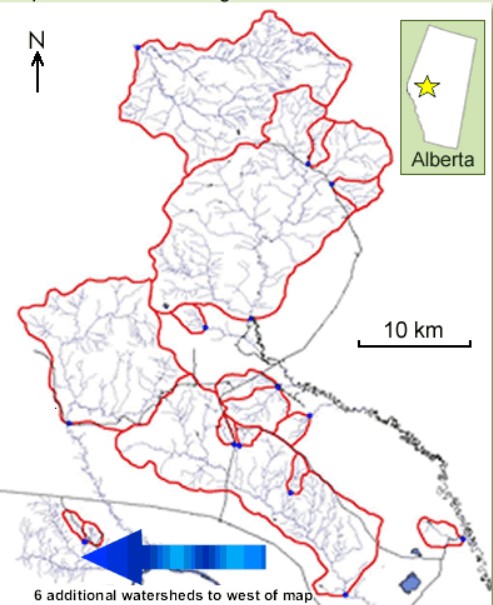Overview
Streams and rivers can be both helped and harmed by forest disturbance. Disturbance creates fish habitat in forest streams, but can also increase sediments and alter water chemistry. The FORWARD project operated for over a decade in Alberta and Ontario to measure how water in the boreal forest was changed by industrial and natural disturbances.

Photo credit: fRI Research
Background
Ecosystem Based Management is a knowledge-based enterprise. Knowledge can be gathered in several ways, but in forests where disturbances are driving hydrological processes, field-based experiments and monitoring are key tools. The Forest Watershed and Riparian Disturbance Project (FORWARD) was set up in 2005 to study how rivers and streams in forests that were disturbed by fires, forestry, oil and gas exploration or mining were changed by these activities.
This project compared water quality and quantity in disturbed and undisturbed forests over a 10 year period. During that time, with the support of a dozen industry and government partners and 20 graduate students, post-doctoral and university faculty, this project explored water quality, toxicity, vegetation community stability, effects on reptiles and amphibians, snow accumulation and melt, soils and monitoring methods.
The goal of this project was to create a large and comprehensive database that could serve as a permanent record of how to effectively manage forests and water-bodies in disturbance-based ecosystems.

Photo credit: fRI Research
Innovation
FORWARD’s innovation was to seek a comprehensive answer to a simple question: How does disturbance affect boreal forest water-bodies? As well, by collecting long-term monitoring data and storing where it can be accessed permanently from anywhere, this project has become a source of knowledge for managers pursuing ecosystem based solutions for boreal forest ecosystem services.
Discovery
Although there were many findings (about 75 papers were published over that time), the key results compared burned to harvested forests. Runoff was typically greater in burned, compared to unharvested forests. The exception was when snow was dominant and snow melt was accelerated in burned forests. Nutrients in runoff from harvested forests were greater than in reference forests during peak flow, but indistinguishable when flow declined to baseline levels. Riparian buffers had no effect. Harvest intensity (less than 50% of a watershed) was more important than riparian buffers in harvested watersheds and they responded similarly to burned watersheds initially but recovered more quickly (after five years) to pre-disturbance values. Indeed, The role of wetlands in mitigating impacts to runoff following harvesting obscured any mitigating influence of riparian buffers.
Where in the wheel?
The key word in EBM is management. Modern landscapes experience a range of human-caused and natural disturbances, and to continue to extract economic and social value from these landscapes, both must be managed to achieve ecological integrity goals. Managing in an information vacuum is not recommended. This means learning best practices from stakeholders, partners and regulators, as well collecting information on the real impacts of dominant disturbances. The FORWARD project achieved the latter through a decade of experiments and monitoring, informing best management practices for the provision of clean water from disturbed forests.


